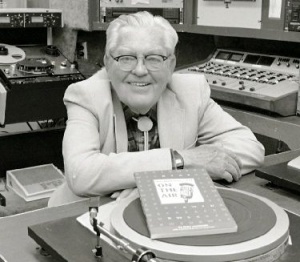Personal tools
Help
Tools
Class Notes
- Do you have news for fellow WSU alumni and other readers of Washington State Magazine? Send us your class note.
Our Story
written by alumni, faculty and friends.
NOTE: THIS IS A LEGACY SITE AND IS NOT REGULARLY MAINTAINED
Views
Harrison National Public Radio pioneer
From Our Story
From Washington State Magazine, Summer 2004
Whether plinking on the piano or pounding out scripts for public radio on his manual typewriter, Burton D. “Burt” Harrison enjoyed life to the fullest. During 27 years on the Washington State University communications faculty, including 17 as manager of KWSU Radio, he figured significantly in the formation and development of public broadcasting. Moreover, he exerted a positive influence on scores of students pursuing careers in broadcast journalism.
Harrison, 87, died January 22, 2004, in Centralia. Dee, his wife of 63 years, preceded him September 4, 2003.
To help finance his education at Kansas State Teachers College, the Atchison native played honky-tonk piano in nightclubs and even did a stint as a mortuary organist. He earned an English degree in 1943, and joined The Emporia Gazette staff.
After completing military service during World War II, he returned to his alma mater as radio production director and assistant manager of KTSW. He got his start in Colorado commercial broadcasting as station manager of KSFT, Trinidad, and at KOKO, La Junta. He earned a master’s degree from the University of Denver.
At WSU (1949-1976), Harrison became one of public radio’s most influential spokesmen and colorful personalities. He wrote thousands of radio scripts—from drama to prize-winning science commentaries. His show, Literary Scrapbook, was distributed to nearly 50 stations. He also wrote for National Public Radio. His articles, reviews, and feature stories appeared in the New York Herald-Tribune, Washington Star, Washington Post, Newsweek, and Popular Science.
“Burt was a wonderful writer—at best when facing a deadline,” says Robert Mott, San Diego, WSU professor (1956-68) and Department of Communications chair. Folklore at KWSC-AM in the ’40s and ’50s was that Harrison would a give the announcer the first 10 or 12 minutes of a script and finish the last three to five minutes while the first segment was being aired.
He was writer-producer for 16 film and television documentaries, including This is WSU, To Build a Dam, The Comedians, and Mosaic. In 1975 he was selected to deliver WSU’s 36th Invited Faculty Address. In it, he said public broadcasting is the best means of adding “diversity and greater purpose to American television and quality to the diversity already existing in radio.” He noted the three commercial television networks “have to offer essentially the same strawberries and ice cream, not out of desire but simply as a matter of survival.” The whole system of television programming “is designated to give the majority what it wants.”
"Without the efforts of Harrison and a few colleagues, National Public Radio would not exist today,” Mott says. “He was a key person in the task force that lobbied Congress to include radio [television was already included] in the Public Broadcasting Act of 1976.”
Harrison’s honors include Emporia State’s Alumni Achievement Award, 1977, and the Washington State Association of Broadcasters’ Broadcaster of the of the Year Award, 1987. He conducted an oral history project for the Corporation of Public Broadcasting in 1977-78. In 1993, he completed Washington State on the Air, a history of radio and television at WSU.
Val Limburg joined the faculty in 1967, when the communications department and KWSU Radio were still blended together. He remembers Harrison listening to students auditioning for announcing positions. He would deliberately introduce words like “Grand Prix race” into the script and chuckle as the naïve student invariably mispronounced the term.
Students loved Harrison and his subtle humor in the classroom. In his office, he’d monitor the student station via a volume meter mounted above his desk. “He might not always listen, but he would watch that meter and make sure there was a constant sound emanating from the station,” Limburg said.
“The Sage of the Palouse” had a large following for his Behind the Mike radio series that made the ficticious small Montana town of Elephant’s Breath famous.
After he retired, he and Dee would sit in the press box at Bailey Field, where he played the organ at baseball games. His rendition of “Take Me Out to the Ballgame” was the fans’ favorite. The Harrisons were longtime residents of nearby Albion, where Burt served as mayor for many years.
Our Story site map
Our Story main page | Our Story categories | Help Desk
Contact | Give | Advertise
Washington State Magazine | Washington State University | Class Notes
Our Story is coordinated by
In partnership with
Our Story and Washington State Magazine are publications of Washington State University. All rights reserved.
P.O. Box 641227, Washington State University, Pullman, WA 99164-1227 USA | wsm@wsu.edu, 509-335-2388
Accessibility | Copyright | Policies

